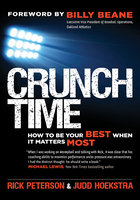
Preface
The privilege of a lifetime is to be the best of who you are and to exercise that privilege every day.
—RICK PETERSON
In the spring of 2013, I received a call from someone seeking to write a book with leadership guru Dr. Ken Blanchard. After working with Ken for almost 15 years, I’ve heard this request many times. However, this request was unlike any of the others. I stood up and took notice.
The caller was Rick Peterson, the most renowned pitching coach on the planet. He coached the Oakland Athletics pitching staff during the famed Moneyball era. He also coached a New York Mets pitching staff comprised of All-Stars, Cy Young Award winners, and Hall of Famers. Being a former college baseball player and lifelong fan of the game, I was thrilled to be speaking with Rick. When it comes to pitching coaches, he is the pitching coach.
Rick shared that he felt a kinship with Ken, the coauthor of the runaway bestseller The One Minute Manager. He highlighted how a pitching coach is the ultimate One Minute Manager. He is responsible for setting clear goals, praising progress toward the goals, and redirecting performance when it’s off track. But Rick also pointed out one big difference.
A pitching coach doesn’t operate in your typical office environment. He is the only coach in professional sports who provides in-game coaching on the field of play. He must calm his pitcher down in front of millions of fans, with the game on the line, in 30 seconds or less. Also, everyone watching will know within minutes whether or not the coaching worked.
Ken let Rick know he would love to work with him but was committed to other book projects for the next few years. Knowing my expertise and passion for leadership, coaching, and sports, Ken recommended I work with Rick. When I suggested this idea to Rick, he welcomed me with open arms. So began our odyssey.
In addition to my excitement to share Rick’s unique perspective and expertise with you, I had a secret and selfish reason for working with him. Despite my success in amateur athletics and now in business, I have vivid nightmares from choking at crunch time. I’m not alone. Performing at less than your best in high-pressure situations is a universal problem. I see it wherever I turn—at work and in everyday life.
Help is on the way. Consider Rick your personal coach. In addition, Crunch Time shares the performance-under-pressure secrets gathered from my interviews with a number of other elite leaders, coaches, and performers. If you’re a baseball fan, you’ll recognize Oakland A’s General Manager Billy Beane of Moneyball fame, Hall of Famer Tom Glavine, Cy Young Award winner Barry Zito, and the inspirational Olympic hero Jim Abbott. I also tap into the wisdom of elite performers outside of baseball, including CEOs, executive coaches, leadership guru Ken Blanchard, and award-wining Director Stephen Soderbergh. Rick and I are fortunate to call these individuals our friends.
While Crunch Time shares a number of entertaining, behind-the-scenes stories from Rick’s career in baseball, you don’t need to be a baseball fan to find this book enjoyable and valuable. The lessons shared transcend baseball, applying to the everyday pressure situations you face.
Furthermore, the lessons shared by the elite leaders, coaches, and performers are not just for the elite; they are relevant and valuable for everyone. Throughout the book, I share how I’ve applied what I’ve learned and the resulting fruit from the shifts in my thinking.
For example, in 2015, my first full year of consciously reframing pressure situations from threat to opportunity, the annual sales revenue I am responsible for increased 25 percent! The customers my teammates and I serve also achieved great outcomes. Based on these results and how they were achieved, I earned a promotion to Vice President. In this new role, I have more responsibility, more pressure, and more opportunity to expand my influence and impact.
Here’s one quick piece of advice before you dive in: read the Introduction, Chapter 1, and Chapter 2 in order. These serve as the foundation for the rest of the book. Following Chapter 2, you may choose to read Chapters 3–8 in whatever sequence suits you best.
—Judd Hoekstra